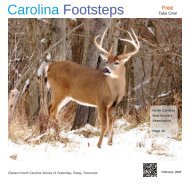Footsteps October 2019
October edition of the Carolina Footsteps now online.
October edition of the Carolina Footsteps now online.
- No tags were found...
Create successful ePaper yourself
Turn your PDF publications into a flip-book with our unique Google optimized e-Paper software.
Fall Shoes<br />
10 to-dos for home and yard winterization <strong>October</strong> <strong>2019</strong> FASHION 17<br />
Embroidered<br />
Bootie<br />
(BPT) - Scarves. Pumpkin spice lattes. Leaves<br />
crunching underfoot. Sweater season is moving<br />
in fast, which means it’s time to start transitioning<br />
to fall maintenance to make sure your home<br />
and yard are ready for winter. The following are<br />
10 things you can do to prepare for the cold and<br />
wet weather ahead.<br />
1. Interseed your lawn<br />
A summer of heavy use can take its toll on even<br />
the healthiest of lawns. If your turf has some<br />
thin or bare patches, fall is the ideal time to<br />
reseed. A turf specialist at a garden shop or university<br />
extension office can help you choose the<br />
right kind of seed for your local conditions. After<br />
spreading the seed, water lightly and frequently<br />
(if it doesn’t rain) to keep the soil slightly damp<br />
until the seed germinates.<br />
Suede Flats<br />
Open Toe<br />
Buckle<br />
Metallic Leather<br />
Snakeskin Prints<br />
For those who live in the warmer, Southern regions<br />
of the U.S., interseeding with cool season<br />
grass seed can help you enjoy a lush green<br />
lawn year-round. Speak with a local landscaper<br />
or your university extension office to determine<br />
the best timing, seed and process for interseeding<br />
with cool season grasses as warm season<br />
lawns turn dormant.<br />
2. Winterize your irrigation system<br />
If the ground in your area freezes down to the<br />
depth of your irrigation pipes during the winter,<br />
be sure to shut off the water to the system and<br />
drain the pipes before the first freeze.<br />
3. Lower your mower blades<br />
For the last few mowings in the fall (and the<br />
first few in the spring), set your lawn mower<br />
blades at the lowest recommended height for<br />
your type of turf. You no longer need the height<br />
of the grass to shade the soil and keep it cool,<br />
and minimizing the amount of moisture that’s<br />
trapped by the grass can help prevent fungal<br />
disease.<br />
4. Remove the leaves<br />
Don’t leave your lawn buried under a thick layer<br />
of leaves. If you don’t want to rake, try mulch<br />
mowing - chopping the leaves up into small<br />
pieces allows them to decompose more quickly,<br />
so that they fertilize the grass instead of suffocating<br />
it. You may need to mow more frequently<br />
to keep up with the falling leaves, even if the<br />
grass itself isn’t growing quickly.<br />
5. Clean up your yard<br />
Any object that sits on your grass all winter<br />
can create a dead spot. To protect your lawn,<br />
remove toys, furniture and other items from<br />
the grass. Be sure to cover or store anything<br />
that’s not designed to be out in the rain or snow<br />
indoors.<br />
6. Prep your equipment for spring lawn care<br />
In addition to seeding, another great way to<br />
get a jumpstart on spring is to give your lawn<br />
mower a tune-up. By sharpening the blades<br />
before you put it away for the winter, it will be<br />
ready to get back to work when the grass starts<br />
growing again in the spring.<br />
7. Check your roof, gutters and downspouts<br />
Leaks can lead to costly water damage, so<br />
check for potential trouble spots now, before the<br />
winter storms start. Look for broken shingles<br />
and damaged flashing around vents, chimneys<br />
and skylights; clean the leaves out of your gutters;<br />
and add extensions to your downspouts if<br />
the water runs less than three feet away from<br />
the foundation of the house.<br />
8. Check your doors and windows for leaks<br />
Eliminating air leaks around doors and window<br />
frames is one of the most effective ways<br />
to lower your heating bills. Caulk and replace<br />
weatherstripping where needed to prevent cold<br />
air (and potentially water) from entering. Don’t<br />
forget to make sure the seal between the garage<br />
door and the ground is tight as well.<br />
9. Service your heating system<br />
Before you turn your heating system on for the<br />
winter, have it cleaned and inspected by a professional.<br />
Regular preventive maintenance will<br />
keep it running safely and efficiently and make<br />
sure minor issues are resolved before they<br />
become major problems.<br />
10. Test your emergency power generator<br />
Winter wind and ice storms can bring down<br />
power lines and cause lengthy blackouts. If<br />
you live in an area where power outages are<br />
common and you have an emergency backup<br />
generator, test it now, and make sure you have<br />
engine oil and filters on hand.<br />
Spending a bit of time in the fall to prepare your<br />
home and yard will allow you to enjoy the winter<br />
months with peace of mind. What’s more, the<br />
effort you invest in the health of your lawn now<br />
can pay dividends in the spring by jumpstarting<br />
your turf’s growth and minimizing weeds. Have<br />
you completed everything on the list? It must be<br />
time to curl up with a good book, a hot beverage<br />
and relax!<br />
photo by Alan Light<br />
Don’t ever humiliate a<br />
man. If you’re gonna<br />
have to dress him out,<br />
you take him aside and<br />
do it that way. That’s<br />
the one thing I don’t like<br />
about Hollywood: They<br />
go in for public humiliation.<br />
You shouldn’t do<br />
that to a man.<br />
--Rip Torn
















